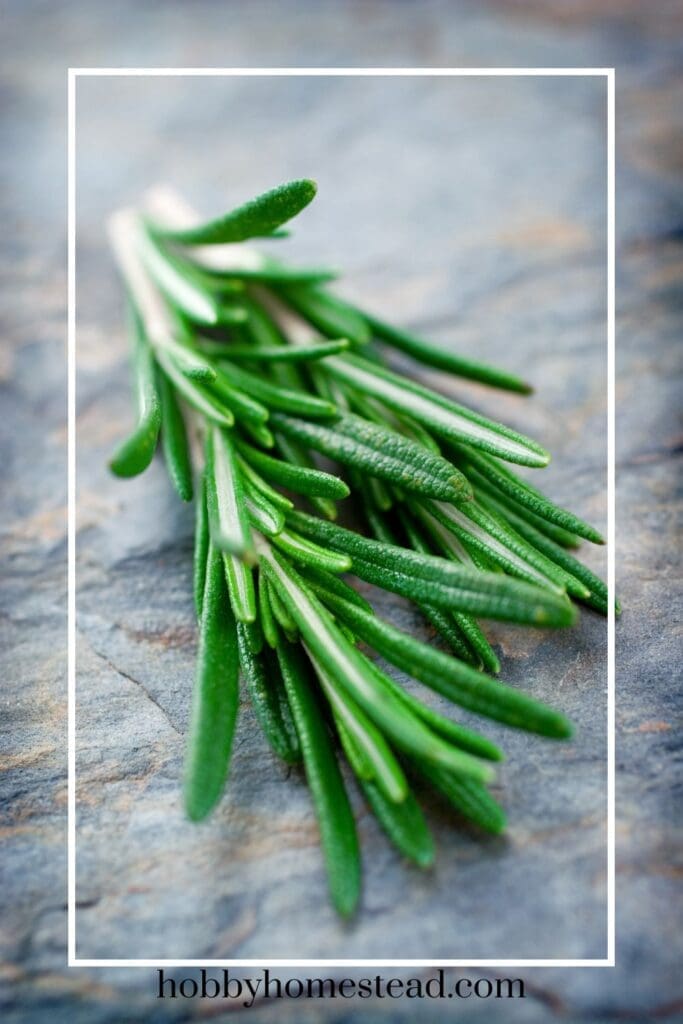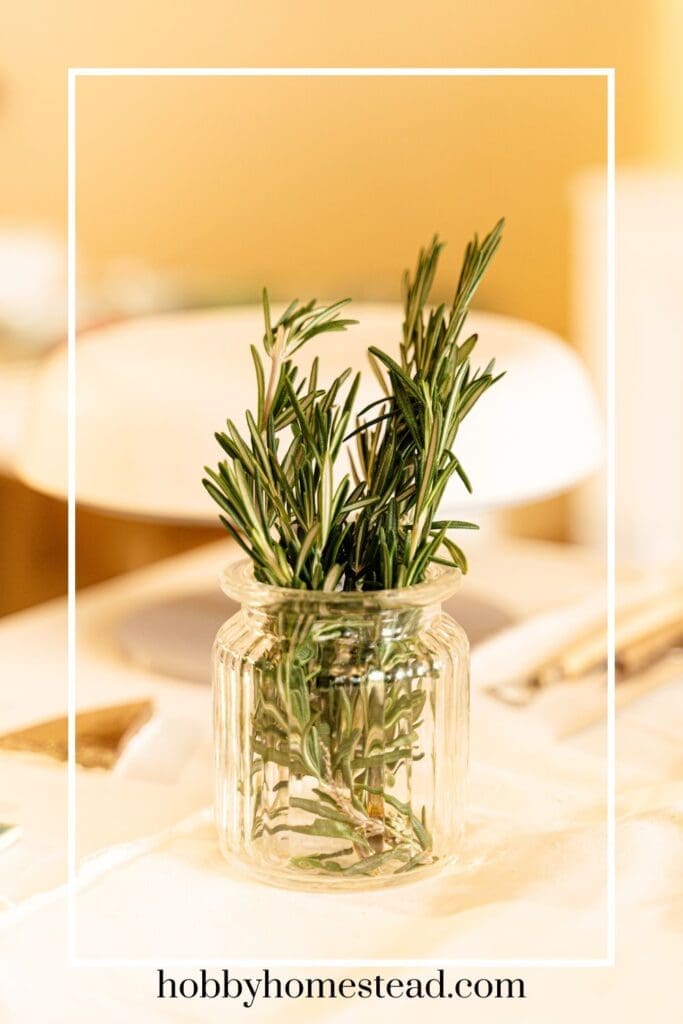Let’s talk about how to grow rosemary. There’s something so satisfying about snipping a few fragrant sprigs of rosemary from a plant you grew yourself. Whether it’s adding flavor to roasted potatoes, tossing it into fresh bread dough, or just brushing your hand across the leaves for that calming aroma.
I love the smell of fresh rosemary. It has a way of making a home feel cozy and alive. My dad thought it was supposed to go into every recipe he ever made. That is a bit too much for me. But there are a wide range of uses for the herb from recipes to hair rinse.
Over the years, I’ve tried just about every way to grow rosemary. From slow-but-steady seed starts to the instant gratification of rooting supermarket cuttings. And I’ve learned that with a little patience, the right soil, and some sunshine, anyone can grow this hardy evergreen shrub at home.

Best Soil for Rosemary in Pots
The first mistake I made with rosemary? I gave it too much love. Specifically, too much water and soil that held on to moisture.
Did you know that rosemary is native to the Mediterranean. So, it prefers soil that’s on the drier, sandier side.
For container planting, I’ve had the best luck with a well-draining potting mix. I often mix in a bit of coarse sand or perlite to help keep things airy.
If you’re using a two- to four-inch pot for young plants, make sure it has good drainage holes. As your plant matures, you’ll need to transplant to a larger container. Especially once you see signs of new growth and healthy roots developing.
How to Plant Rosemary Seeds
Starting rosemary from seed isn’t the fastest method, but it’s incredibly rewarding. I usually start mine indoors around late winter, so the young plants are ready for warmer weather come spring.
The best way I’ve found is to use soil blockers or plug trays, fill them with a well-draining potting mix, and gently press in the rosemary seeds. Don’t bury them too deep; just a light press and a misting of room temperature water will do. Then I cover them loosely with a clear plastic bag to trap humidity and place them in a bright spot, like my south-facing window or under a grow light.
It takes a long time for rosemary seeds to sprout. Sometimes for up to three weeks. But when those first tiny aromatic leaves peek through, it’s totally worth it.
When to Plant Rosemary Seeds
If you’re wondering about timing, the best time to start rosemary seeds indoors is between late winter and early spring. Outdoors, wait until the last frost has passed and you’re solidly in the growing season.
If you live in colder zones, give yourself a head start by starting seeds indoors during the winter months. I’ve even started some near my kitchen sink, where the light hits just right and I’m reminded to mist them daily.
How Long Does Rosemary Take to Grow?
Here’s the honest truth—rosemary takes a while to get going. From seed, it can be up to a year before you have an established plant that’s hearty enough for harvesting. But once it’s settled in, rosemary is surprisingly tough.
If you’re after quicker gratification, growing from rosemary cuttings (especially from the grocery store) is the easier way to go.

How to Grow Rosemary from Cuttings, Supermarket or Other
One of my favorite ways to grow rosemary is from stem cuttings. I’ve had a lot of success using sprigs from a healthy rosemary plant in my garden, or even from a supermarket bundle that smelled just too good to toss after cooking.
Look for semi-ripe cuttings. Those green stems that are just starting to turn a little woody at the bottom.
I usually take a 4–6 inch cutting from the top of the stem, just below a leaf node, and strip off the lower leaves.
From there, you can either dip the cut end into rooting hormone powder—an optional step, but one I use for a better success rate—or simply pop it into clean water.
I’ve rooted cuttings in a small container on the windowsill, changing the water every few days until I see new roots. Once those new roots are about an inch long, I plant them in a small pot with well-draining potting soil and keep them in indirect light until they’re strong enough for direct sunlight.
Watching new rosemary plants come to life this way is still one of my favorite parts of gardening.
Harvesting and Using Rosemary
Once your rosemary plant is well established and showing signs of new growth. Usually after a few months. You can begin harvesting.
I like to snip sprigs in the morning when the aromatic oils are strongest. Simply take a pair of sharp scissors and cut a few inches off the top part of the stem, right above a pair of leaves. This encourages bushier new growth and keeps your plant nice and full.
Fresh rosemary is a kitchen staple in my house. Toss sprigs on sheet pan chicken dinners, add chopped leaves to homemade focaccia, and even infuse olive oil with it.
If you’re into crafts or natural living, you can dry rosemary for sachets, herbal wreaths, hair rinse, or homemade cleaning sprays. It’s a small herb with big potential!
Why Is My Rosemary Plant Turning Brown (and Other Growing Issues)
If your rosemary is turning brown or dropping leaves, don’t panic. It’s usually fixable. I’ve found the most common issue is overwatering or soil that doesn’t drain well.
Rosemary doesn’t like wet feet! Make sure your pot has good drainage, and avoid watering until the soil feels dry at the top. Brown tips can also mean too little sunlight, so be sure your plant is in a sunny location for at least six hours a day.
In the winter months, plants can suffer if they’re near cold drafts or heaters. I lost one lovely plant to a chilly windowsill one January—lesson learned. If you’re keeping rosemary indoors over winter, aim for a bright spot with some humidity and don’t overdo the watering.
Leggy or sparse growth usually means it needs more light. This herb craves a sunny location or at least 6–8 hours of direct sunlight daily. In colder zones or during winter months, a grow light can work wonders.
If your cuttings aren’t rooting, check the moisture levels. Too wet, and they rot. Too dry, and they wither. I’ve had better results using a mix of equal parts coarse sand and potting soil, covering the cuttings with a clear plastic bag to maintain humidity.
Indoor vs. Outdoor Growing Tips
Growing rosemary indoors is convenient and cozy, especially when you can snip a sprig right over the kitchen sink! But it does have its challenges. Indoors, the air can be dry, and light levels are often too low.
Try placing your plant near a south-facing window or under a grow light. Keep it away from drafts or heaters that can dry it out. Water only when the top inch of soil is dry, and rotate the pot occasionally for even growth.
Outdoors, rosemary thrives in full sun and well-draining soil. It does especially well in raised beds, containers, or even as a low hedge if you’re in a warmer zone.
Just make sure it’s protected from heavy rain and has good air circulation to prevent mildew.

❄️ Winter Care for Rosemary
If you live somewhere with cold winters like I do, your rosemary will need a little extra love when temperatures drop. While rosemary is technically an evergreen shrub, it can’t survive freezing temps unless it’s a hardy variety.
In colder zones, I like to pot my rosemary and bring it inside in late autumn. If you’re leaving it outdoors, mulch around the base to protect the roots and place the pot against a south-facing wall to soak up any warmth.
And remember: winter = less light and slower growth. Cut back on watering, and don’t worry if you see less action. It’s just resting until warmer weather returns.
🌿 Companion Herbs to Grow with Rosemary
Rosemary doesn’t just shine on its own. It plays well with other herbs too! If you’re creating a small herb garden, consider pairing it with thyme, oregano, sage, or lavender. These woody herbs enjoy similar conditions: full sun, well-draining soil, and infrequent watering.
Avoid grouping rosemary with thirsty plants like basil or mint, which prefer more moisture and richer soil. It’s all about finding that balance so everyone gets what they need.
I like to keep my rosemary in its own pot so I can move it around based on the season, but it looks beautiful nestled beside thyme in a terra cotta container on my patio.
How to Dry Rosemary
When I have an abundant harvest—or just want to save those aromatic leaves from a trimming—I dry rosemary for later use. My go-to method is to tie small bundles of woody stems together and hang them upside down in my pantry or a warm, dry room.
After a week or two, the leaves crumble easily. You can also use a dehydrator or set your oven to the lowest setting for a few hours.
Once dried, strip the leaves from the stems and store them in glass jars or reusable containers. It’s amazing how that scent lingers.
Fresh vs Dried Rosemary
Both fresh and dried are great. But they’re used a little differently. Fresh rosemary is vibrant and lovely in roasted vegetables or bread dough. It gives off such a rich scent when the oils release.
Dried rosemary, on the other hand, is more concentrated. Use about one-third of the amount of dried if a recipe calls for fresh. Both come from the same parent plant, and both keep that unmistakable piney, herbal flavor.
How Long Does Fresh Rosemary Last?
If you keep fresh rosemary in the fridge wrapped in a damp paper towel and sealed in a plastic bag or airtight container, it will last about 10 to 14 days. You can also freeze it. Just hop it up and place it in ice cube trays with a little olive oil or water for easy access. In dried form, of course, it keeps for a long time in a cool, dark place.
Ready to Try Growing That Sprig From the Supermarket?
Whether you’re planting rosemary seeds, rooting rosemary cuttings, or giving that grocery store sprig a second life, rosemary is a truly rewarding herb to grow. It brings flavor, fragrance, and a little greenery into your day. It teaches patience too.
If you haven’t already, go ahead and take that stem from last night’s dinner and pop it into some clean water. In a few weeks, you just might have a new rosemary plant to call your own.


